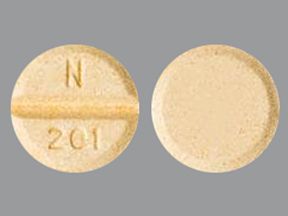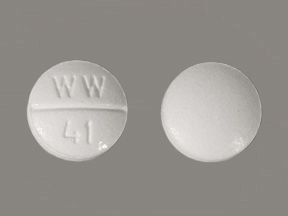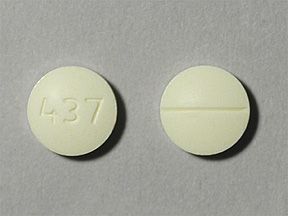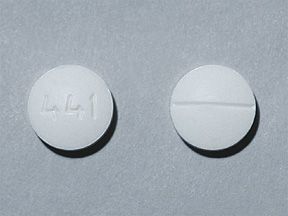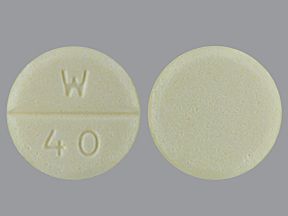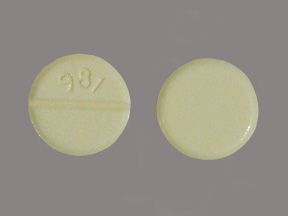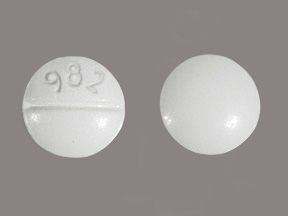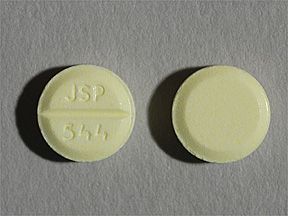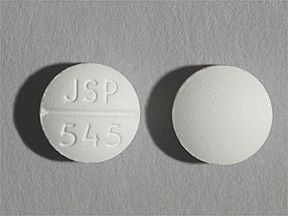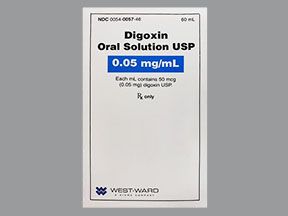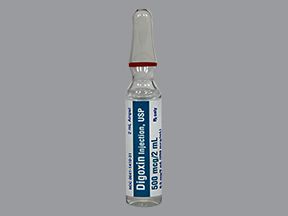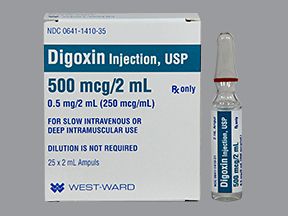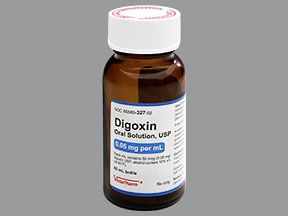Highlights for digoxin
- Digoxin oral tablet is available as both a generic and brand-name drug. Brand name: Lanoxin.
- Digoxin is also available as an oral solution.
- Digoxin oral tablet is used to treat atrial fibrillation, mild to moderate heart failure in adults, and heart failure in children.
Digoxin is a prescription drug. It comes as an oral tablet and an oral solution.
Digoxin oral tablet is available as the brand-name drug Lanoxin. It’s also available as a generic drug. Generic drugs usually cost less than the brand-name version. In some cases, the brand-name drug and the generic version may be available in different forms and strengths.
Why it’s used
Digoxin is used to treat atrial fibrillation and heart failure.
How it works
Digoxin belongs to a class of drugs called antiarrhythmics.
It works by slowing your heart rate down and improving the way your ventricles are filled with blood. Your ventricles are two of the four chambers of your heart.
Digoxin oral tablet does not cause drowsiness. However, it can cause other side effects.
More common side effects
The more common side effects that can occur with digoxin include:
- diarrhea
- dizziness
- headache
If these effects are mild, they may go away within a few days or a couple of weeks. If they’re more severe or don’t go away, talk to your doctor or pharmacist.
Serious side effects
Call your doctor right away if you have serious side effects. Call 911 if your symptoms feel life-threatening or if you think you’re having a medical emergency. Serious side effects and their symptoms can include the following:
- Allergic reactions. Symptoms can include:
- skin rash
- hives
- itching
- swelling of your face, lips, or tongue
- trouble breathing
- Changes in vision. Symptoms can include:
- blurred vision
- vision with a yellow-green tint
- Mental changes. Symptoms can include:
- inability to think clearly
- anxiety
- depression
- hallucinations
- Neurological problems. Symptoms can include:
- confusion
- changes in behavior, such as hallucinations and psychotic episodes
- feeling lightheaded or faint
- headache
- Gastrointestinal problems. Symptoms can include:
- nausea or vomiting
- persistent diarrhea
- severe stomach pain
- Fast, irregular heart rate
- Unexplained bleeding or bruising
- Unusual weakness or tiredness
Disclaimer: Our goal is to provide you with the most relevant and current information. However, because drugs affect each person differently, we cannot guarantee that this information includes all possible side effects. This information is not a substitute for medical advice. Always discuss possible side effects with a healthcare provider who knows your medical history.
Digoxin oral tablet can interact with other medications, vitamins, or herbs you may be taking. An interaction is when a substance changes the way a drug works. This can be harmful or prevent the drug from working well.
To help avoid interactions, your doctor should manage all of your medications carefully. Be sure to tell your doctor about all medications, vitamins, or herbs you’re taking. To find out how this drug might interact with something else you’re taking, talk to your doctor or pharmacist.
Examples of drugs that can cause interactions with digoxin are listed below.
Heart failure drug
Taking digoxin with ivabradine, a heart failure drug, can increase your risk of side effects. These side effects include bradycardia (a slowed heart rhythm). If you need to take these drugs together, your doctor may monitor you closely.
Heart rhythm drugs
Taking digoxin with certain heart rhythm drugs may increase the levels of digoxin in your body and increase your risk of side effects, including heart problems. If you need to take these drugs with digoxin, your doctor may monitor you closely.
Examples of these drugs include:
- amiodarone
- quinidine
- dofetilide
- dronedarone
- propafenone
- sotalol
HIV medications
Taking digoxin with certain HIV drugs can increase the level of digoxin in your body. This could cause increased side effects. If you need to take these drugs with digoxin, your doctor may lower your dose of digoxin before you start taking these medications.
Examples of these drugs include:
- ritonavir
- saquinavir
- lopinavir/ritonavir
Blood pressure drugs
Taking digoxin with certain blood pressure medications can increase the level of digoxin in your body. If you need to take these drugs with digoxin, your doctor will likely reduce your digoxin dosage first. They may also monitor your digoxin levels during your treatment with these drugs.
Examples of these drugs include:
- captopril
- carvedilol
- diltiazem
- verapamil
- nifedipine
- spironolactone
- telmisartan
Antibiotics
Taking digoxin with certain antibiotics can increase digoxin levels in your body. If you need to take these drugs with digoxin, your doctor will likely reduce your digoxin dosage first. They may also monitor your digoxin levels during your treatment with these drugs.
Examples of these drugs include:
- azithromycin
- clarithromycin
- erythromycin
- gentamicin
- trimethoprim
- tetracycline
Immune-suppressing drug
Taking digoxin with cyclosporine can increase digoxin levels in your body. If you need to take cyclosporine with digoxin, your doctor will likely reduce your digoxin dosage first. They may also monitor your digoxin levels during your treatment with cyclosporine.
Cholesterol-lowering drug
Taking digoxin with atorvastatin can increase digoxin levels in your body. If you need to take atorvastatin with digoxin, your doctor will likely reduce your digoxin dosage first. They may also monitor your digoxin levels during your treatment with atorvastatin.
Antifungal drugs
Taking digoxin with certain antifungal drugs can increase digoxin levels in your body. If you need to take these drugs with digoxin, your doctor will likely reduce your digoxin dosage first. They may also monitor your digoxin levels during your treatment with these drugs.
Examples of these drugs include:
- itraconazole
- ketoconazole
Nonsteroidal anti-inflammatory drugs (NSAIDs)
Taking digoxin with NSAIDs can increase digoxin levels in your body. If you need to take these drugs with digoxin, your doctor will likely reduce your digoxin dosage first. They may also monitor your digoxin levels during your treatment with NSAIDs.
Examples of NSAIDs include:
- indomethacin
- ibuprofen
- diclofenac
Antidepressant
Taking digoxin with nefazodone can increase digoxin levels in your body. If you need to take this drug with digoxin, your doctor will likely reduce your digoxin dosage first. They may also monitor your digoxin levels during your treatment with nefazodone.
Antimalarial drug
Taking digoxin with quinine can increase digoxin levels in your body. If you need to take this drug with digoxin, your doctor will likely reduce your digoxin dosage first. They may also monitor your digoxin levels during your treatment with quinine.
Chest pain drug
Taking digoxin with ranolazine can increase digoxin levels in your body. If you need to take this drug with digoxin, your doctor will likely reduce your digoxin dosage first. They may also monitor your digoxin levels during your treatment with ranolazine.
Stimulant drugs
Taking digoxin with drugs called stimulants can lead to an irregular heart rhythm. Examples of these drugs include:
- epinephrine
- norepinephrine
- phenylephrine
Neuromuscular blocker
Taking digoxin with succinylcholine can lead to an irregular heart rhythm.
Drugs used to treat low sodium levels
Taking digoxin with certain drugs used to increase sodium levels in your blood may increase digoxin levels in your body. If you need to take these drugs with digoxin, your doctor will likely reduce your digoxin dosage first. They may also monitor your digoxin levels during your treatment with these drugs.
These medications are:
- tolvaptan
- conivaptan
Cancer drug
Taking digoxin with lapatinib can increase digoxin levels in your body. If you need to take this drug with digoxin, your doctor may need to adjust your digoxin dosage.
Proton pump inhibitors
Taking digoxin with proton pump inhibitors (PPIs) can increase the levels of digoxin in your body. If you need to take these drugs with digoxin, your doctor may need to adjust your digoxin dosage.
Examples of PPIs include:
- rabeprazole
- esomeprazole
- lansoprazole
- omeprazole
Antiplatelet drug
Taking digoxin with ticagrelor can increase digoxin levels in your body. If you need to take this drug with digoxin, your doctor may need to adjust your digoxin dosage.
Overactive bladder drug
Taking digoxin with mirabegron can increase digoxin levels in your body. If you need to take this drug with digoxin, your doctor will likely reduce your digoxin dosage first. They may also monitor your digoxin levels during your treatment with mirabegron.
Propantheline
Taking digoxin with propantheline can increase digoxin levels in your body. If you need to take this drug with digoxin, your doctor will likely reduce your digoxin dosage first. They may also monitor your digoxin levels during your treatment with propantheline.
Disclaimer: Our goal is to provide you with the most relevant and current information. However, because drugs interact differently in each person, we cannot guarantee that this information includes all possible interactions. This information is not a substitute for medical advice. Always speak with your healthcare provider about possible interactions with all prescription drugs, vitamins, herbs and supplements, and over-the-counter drugs that you are taking.
This dosage information is for digoxin oral tablet. All possible dosages and forms may not be included here. Your dose, form, and how often you take it will depend on:
- your age
- the condition being treated
- how severe your condition is
- other medical conditions you have
- how you react to the first dose
Forms and strengths
Generic: Digoxin
- Form: oral tablet
- Strengths: 125 mcg and 250 mcg
Brand: Lanoxin
- Form: oral tablet
- Strengths: 62.5 mcg, 125 mcg, and 250 mcg
Dosage for mild to moderate heart failure in adults
Adult dosage (ages 18 years and older)
- Loading (starting) dose:
- The total dose is 10–15 mcg per kilogram (kg) of body weight divided and taken 3 times per day.
- You should take half of the loading dose first, and then take half of the remaining dose 6 to 8 hours later. Take the rest of the dose 6 to 8 hours after that.
- Maintenance dosage:
- The maintenance dosage is individualized. It’s based on your weight, age, kidney function, current medical conditions, and other medications you may be taking. Your doctor will determine your maintenance dosage.
- The maintenance dosage is taken once per day.
Dosage for atrial fibrillation in adults
Adult dosage (ages 18 years and older)
- Loading (starting) dose:
- The total dose is 10–15 mcg per kilogram (kg) of body weight divided and taken 3 times per day.
- You should take half of the loading dose first, and then take half of the remaining dose 6 to 8 hours later. Take the rest of the dose 6 to 8 hours after that.
- Maintenance dosage:
- The maintenance dosage is individualized. It’s based on your weight, age, kidney function, current medical conditions, and other medications you may be taking. Your doctor will determine your maintenance dosage.
- The maintenance dosage is taken once per day.
Dosage for heart failure in children
Child dosage (ages 11–17 years)
- Loading (starting) dose:
- The total dose is 10–15 mcg per kilogram (kg) of body weight divided and taken 3 times per day.
- Your child should take half of the loading dose first, and then take half of the remaining dose 6 to 8 hours later. They should take the rest of the dose 6 to 8 hours after that.
- Maintenance dosage:
- The maintenance dosage is individualized. It’s based on your child’s weight, age, kidney function, current medical conditions, and other medications they may be taking. Your child’s doctor will determine their maintenance dosage.
- The maintenance dosage is taken once per day.
Child dosage (ages 5–10 years)
- Loading (starting) dose:
- The total dose is 20–45 mcg per kilogram (kg) of body weight divided and taken 3 times per day.
- Your child should take half of the loading dose first, and then take half of the remaining dose 6 to 8 hours later. They should take the rest of the dose 6 to 8 hours after that.
- Maintenance dosage:
- The maintenance dosage is individualized. It’s based on your child’s weight, age, kidney function, current medical conditions, and other medications they may be taking. Your child’s doctor will determine their maintenance dosage.
- The maintenance dosage is taken once per day.
Child dosage (ages 0–4 years)
A safe and effective dosage hasn’t been established for this age group.
Special dosage considerations
- For people with kidney disease: Digoxin is cleared from your body by your kidneys. If you have kidney disease, your dose of digoxin will be lower.
- For people with hypothyroidism: You might be more sensitive to digoxin. Because of this, your dosage of digoxin may need to be reduced.
Disclaimer: Our goal is to provide you with the most relevant and current information. However, because drugs affect each person differently, we cannot guarantee that this list includes all possible dosages. This information is not a substitute for medical advice. Always speak with your doctor or pharmacist about dosages that are right for you.
Digoxin oral tablet comes with several warnings.
High dosage warning
Certain symptoms may indicate that your dosage of digoxin is too high. Call your doctor if you experience:
- nausea
- vomiting
- persistent diarrhea
- confusion
- weakness
- loss of appetite
- abnormal heart rhythm
- problems with vision
Risk of overdose in children
If your child is taking digoxin, make sure you’re aware of the symptoms of overdose in children. These include:
- weight loss
- failure to thrive
- stomach pain
- drowsiness
- behavioral changes
Allergy warning
This drug may cause a severe allergic reaction. Symptoms may include:
- skin rash
- hives
- itching
- swelling of your face, lips, or tongue
- trouble breathing
If you have an allergic reaction, call your doctor or local poison control center right away. If your symptoms are severe, call 911 or go to the nearest emergency room.
Don’t take this drug again if you’ve ever had an allergic reaction to it. Taking it again could be fatal (cause death).
Warnings for people with certain health conditions
For people with ventricular fibrillation: Digoxin can’t be used if you have ventricular fibrillation. It may make your ventricular fibrillation worse.
For people with Wolff-Parkinson-White syndrome: If you have Wolff-Parkinson-White syndrome, you’re at a higher risk for an abnormal heart rhythm. Digoxin may increase your risk even further.
For people with sinus node disease and AV block: Digoxin can cause severe low heart rate and complete heart block if you have sinus node disease or atrioventricular (AV) block. If you have sinus node disease or AV block, you should get a pacemaker before starting digoxin.
For people with preserved left ventricular systolic function: If you have this type of heart failure, you should not use digoxin. It may increase your risk of side effects, such as chest pain and shortness of breath.
For people with a risk of ventricular arrhythmias during electrical cardioversion: If you’re going to receive electrical cardioversion, your dosage of digoxin may be reduced, or your treatment with the drug may be stopped 1 to 2 days before your procedure. This is done to prevent heart rhythm problems.
For people with a heart attack: Digoxin isn’t recommended for people having a heart attack. Using this drug can restrict blood flow to the heart.
For people with myocarditis: You shouldn’t use digoxin if you have myocarditis. It can narrow your blood vessels and cause inflammation.
For people with kidney disease: Digoxin is cleared from your body by your kidneys. If your kidneys don’t work well, the drug may build up to dangerous levels. Your digoxin dosage should be decreased if you have kidney problems.
For people with hypothyroidism: You might be more sensitive to digoxin. Because of this, your dosage of digoxin may need to be reduced.
For people with electrolyte imbalances: If you have low potassium levels, digoxin may be more active in your body, increasing your risk of dangerous side effects.
- If you have low levels of magnesium, your heart may be more sensitive to changes in heart rhythm caused by digoxin.
- If you have low calcium levels, digoxin may not work as well.
Warnings for other groups
For pregnant women: Digoxin is a category C pregnancy drug. That means there haven’t been enough studies done in humans to be certain how the drug might affect the fetus.
Tell your doctor if you’re pregnant or plan to become pregnant. Digoxin should be used during pregnancy only if the potential benefit justifies the potential risk to the fetus.
For women who are breastfeeding: Studies have shown that digoxin passes through breast milk. It’s unknown if this causes any effects in a breastfeeding child. You and your doctor may need to decide if you’ll take digoxin or breastfeed.
For seniors: Seniors may need smaller doses of digoxin and may be monitored more closely. Adults over 65 years old are more likely to have kidney problems, which may lead to greater drug side effects.
For children: This drug hasn’t been established as safe oreffective for use in people under the age of 18 years. However, the drug may still be used to treat heart failure in children.
Digoxin oral tablet is used for long-term treatment. It comes with serious risks if you don’t take it as prescribed.
If you stop taking the drug or don’t take it at all: Your condition may get worse, which can lead to hospitalization or even death.
If you miss doses or don’t take the drug on schedule: Your medication may not work as well or may stop working completely. For this drug to work well, a certain amount needs to be in your body at all times.
If you take too much: You could have dangerous levels of the drug in your body. Symptoms of an overdose of this drug in adults and children can include:
- nausea
- vomiting
- loss of appetite
- fatigue
- irregular heart rate
- dizziness
- vision problems
Other signs of overdose in children and infants include:
- failure to thrive
- behavioral changes, such as hallucinations and psychotic episodes
- weight loss
- stomach pain
- drowsiness
If you think you’ve taken too much of this drug, call your doctor or seek guidance from the American Association of Poison Control Centers at 1-800-222-1222 or through their online tool. But if your symptoms are severe, call 911 or go to the nearest emergency room right away.
What to do if you miss a dose: Take your dose as soon as you remember. But if you remember just a few hours before your next scheduled dose, take only one dose. Never try to catch up by taking two doses at once. This could result in dangerous side effects.
How to tell the drug is working: Your heart rate should return to normal or your symptoms should get better.
Keep these considerations in mind if your doctor prescribes digoxin oral tablets for you.
General
- You don’t have to take digoxin with food.
- You can crush or cut a digoxin tablet.
Storage
- Store digoxin tablets at room temperature between 68°F and 77°F (20°C and 25°C). Store it in its original container to protect it from light.
- Keep the container tightly closed.
- Don’t store this medication in moist or damp areas, such as bathrooms.
Refills
A prescription for this medication is refillable. You should not need a new prescription for this medication to be refilled. Your doctor will write the number of refills authorized on your prescription.
Travel
When traveling with your medication:
- Always carry your medication with you. When flying, never put it into a checked bag. Keep it in your carry-on bag.
- Don’t worry about airport X-ray machines. They won’t damage your medication.
- You may need to show airport staff the pharmacy label for your medication. Always carry the original prescription-labeled container with you.
- Don’t put this medication in your car’s glove compartment or leave it in the car. Be sure to avoid doing this when the weather is very hot or very cold.
Clinical monitoring
During your treatment with digoxin, your doctor will monitor your:
- electrolyte levels
- kidney function
- levels of digoxin (to make sure they’re still safe for you)
- blood pressure and heart rate (you should also check your blood pressure and heart rate each day)
Prior authorization
Many insurance companies require a prior authorization for this drug. This means your doctor will need to get approval from your insurance company before your insurance company will pay for the prescription.
There are other drugs available to treat your condition. Some may be better suited for you than others. Talk to your doctor about other drug options that may work for you.
Disclaimer: Healthline has made every effort to make certain that all information is factually correct, comprehensive, and up-to-date. However, this article should not be used as a substitute for the knowledge and expertise of a licensed healthcare professional. You should always consult your doctor or other healthcare professional before taking any medication. The drug information contained herein is subject to change and is not intended to cover all possible uses, directions, precautions, warnings, drug interactions, allergic reactions, or adverse effects. The absence of warnings or other information for a given drug does not indicate that the drug or drug combination is safe, effective, or appropriate for all patients or all specific uses.

